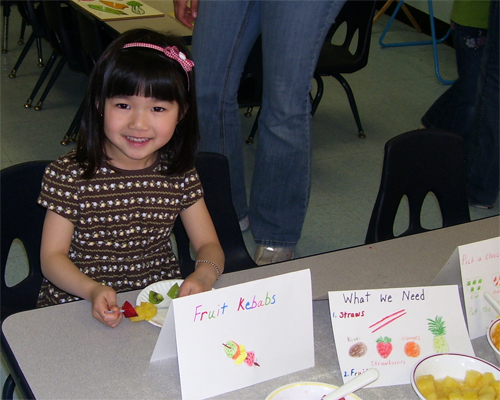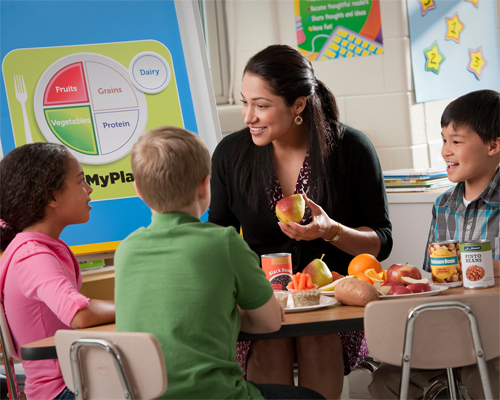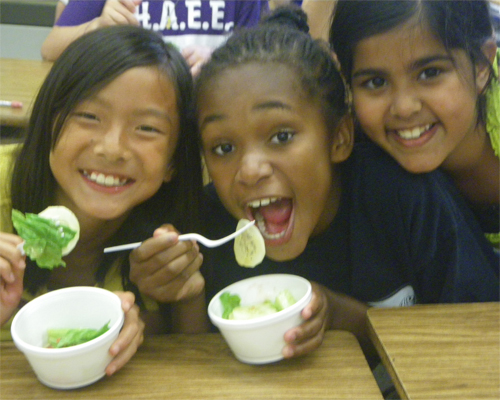
Fact Sheet FS1210
A taste-testing activity is an opportunity for students of all ages to sample a small amount of a single food or a recipe item in the classroom or cafeteria. Students may evaluate foods based on many factors such as taste, smell, appearance, personal preference and willingness to try again. It is also an opportunity to compare foods, for example different varieties of apples, soups, or roasted vegetables.
Why Conduct Tastings in School?
About one-third of the total calories consumed by children come from foods that are high in fat and/or added sugars, while at the same time children are not eating enough "nutrient dense" foods. Nutrient dense foods and beverages are those that provide vitamins, minerals, and other substances that may provide positive health effects with relatively few calories from solid fats and added refined sugars and starches. Vegetables, fruits, whole grains, and fat free milk are all examples of nutrient dense foods that children would benefit from increasing in their diet. However, some children are reluctant to try new foods and it may take repeated exposures to a food before a child likes it. Tastings in school can be a fun way to introduce students to nutrient dense foods and help them improve their eating habits.
Choosing Foods for Tastings
There are a number of reasons to choose a specific food for students to taste including having a curriculum or seasonal connection to a food, a request or inquiry about a food from a student, or a celebration of the harvest of a school garden. Whatever the reason for conducting tastings in school, it is important to choose foods that are nutrient-packed. The key messages of the 2010 US Dietary Guidelines and the MyPlate icon can guide the selection of these food items:
- Make half your plate vegetables and fruits.
- Make at least half your grains whole.
- Switch to fat-free or 1% milk.
Consult with your school nutrition professionals for more ideas. They may be able to supply some of the food, and/or help to prepare it. Assure that the food or recipe you've chosen can be added to the school breakfast or lunch menu if students provide positive feedback from the tasting.
Integrating Taste-Testing Activities into the Curriculum
Students learn by doing. Children are more likely to try a new food when they have an opportunity to be part of the planning of the taste-testing activity. Involve children by having them choose what food or recipe to try and prepare the item(s) for tasting by buying, cleaning, peeling, cutting, mixing, and distributing the samples.
Take a look at how taste-testing activities can be an interactive way to support your curriculum.
Language Arts
- Keep a journal using all senses to describe the foods tasted. Document which foods were preferred over others and how likely they would be eaten again.
- Compare and contrast different varieties of apples, tomatoes, or beans.
- Read or listen to a story, such as Stone Soup by Marcia Brown and then make and taste a vegetable soup.
- For younger children, choose a vegetable or fruit that starts with the "letter of the week."
Mathematics
- Estimate the weight of fresh vegetables or fruits to be sampled, then weigh them and compare the results.
- Compare two different recipes. Have the class vote on the one they like best and would like to see served in the cafeteria. Graph the results.
- Look at the recipe being tasted. Using computation skills expand or reduce ingredients to adjust the number of servings.
- Determine the food cost of the recipe being sampled.
- Sample a variety of whole grain cereals. Have students pour out what they consider to be a single serving of cereal. Next, measure the amount of poured cereal and compare it to the suggested serving size on the label.
History/Social Studies
- When studying Native American culture, sample produce using the "three sisters" method. This includes squash, corn, and beans.
- Taste produce grown in the school garden or foods that are locally grown or produced. Discuss the economic and ecological benefits of eating locally. Map where produce is grown in your county or state.
- Compare different regions within the state or country and discuss how geography, climate, and natural resources influence agriculture. Sample foods from each region.
Science/Technical Subjects
- Discuss photosynthesis and the growing stages of plants.Have a salad party, sampling lettuce or Swiss chard from your school garden with different low fat dressings.
- Taste different plant parts such as carrots as roots, celery as stems, spinach as leaves, broccoli florets as flowers, tomatoes as fruit, and corn kernels as seeds.
Health and Physical Education
- Taste foods from each food group found on MyPlate.
- Read food labels and evaluate different breakfast cereals or bars by comparing their taste, sugar, fat, fiber and calorie content.
Safety First
Food allergies affect people of all ages and are a serious issue. Before selecting a tasting item, check with the school nurse to identify foods to avoid due to allergies or sensitivities.
Practice safe food handling. Check with your school nutrition professionals for your district's food handling policies. Be sure students and volunteers wash their hands properly before handling any food. To ensure clean hands, follow hand washing guidelines from the Centers for Disease Control and Prevention at cdc.gov/handwashing:
- Wet your hands with clean, running water (warm or cold) and apply soap.
- Rub your hands together to make a lather and scrub well; be sure to scrub the backs of your hands, between your fingers, and under your nails.
- Continue rubbing your hands for at least 20 seconds. Need a timer? Hum the "Happy Birthday" song from beginning to end twice.
- Rinse your hands well under running water.
- Dry your hands using a clean towel or air dry them.
Tips for Conducting Tastings
- Know your goal. Is it to increase students' choices of fruits and vegetables, local foods, or healthy snacks?
- Involve as many teachers, school nutrition employees, parents and community partners as possible. Collaborate with Family and Consumer Sciences professionals from your county Cooperative Extension to promote healthy food choices and other wellness initiatives.
- Sample foods that are (or can be) served in the school cafeteria. If the item is a hit then students will be happy to know they can have it on a regular basis, encouraging healthy menu choices.
- Inform parents/guardians of upcoming tasting activites. Encourage them to ask students about what was tasted in school. Include the recipes, so parents/guardians can try at home.
- Invite a local farmer to bring in produce and discuss how it grows.
- Involve students with the preparation, serving, and recording of tasting results.
- Have fun and model positive behavior. Encourage, but do not force children to try new foods.
For More Information Visit:
References
July 2013
Copyright © 2024 Rutgers, The State University of New Jersey. All rights reserved.
For more information: njaes.rutgers.edu.
Cooperating Agencies: Rutgers, The State University of New Jersey, U.S. Department of Agriculture, and Boards of County Commissioners. Rutgers Cooperative Extension, a unit of the Rutgers New Jersey Agricultural Experiment Station, is an equal opportunity program provider and employer.



